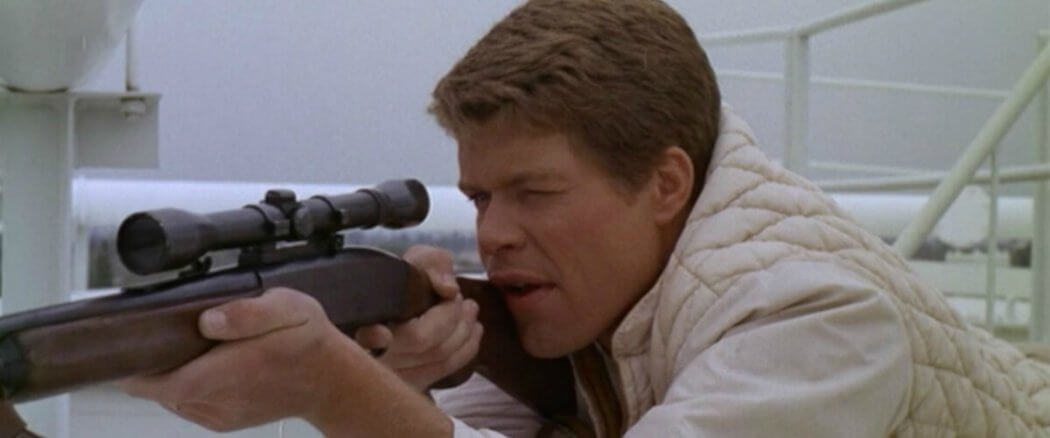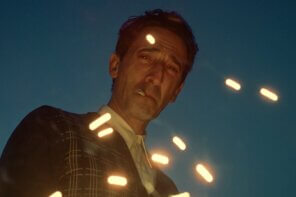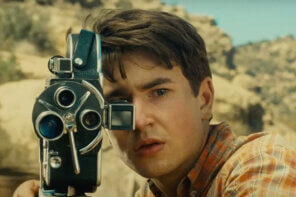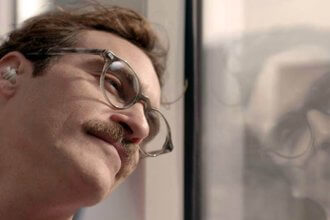“The terms amok, a Malayan word, and berserk, a Norse word, have been used to describe individuals going on killing sprees,” says Grant Duwe, author of Mass Murder in the United States: A History. “Both terms have been around for centuries, which reflects the fact that mass murder is neither a modern nor a uniquely American phenomenon.”*
One might be convinced otherwise, spinning through the U.S. news cycle of 2015.** But then one might have been similarly convinced in the U.S. of 1966. Every era believes it is living in end times, and even though we do not know the day or the hour, we suspect it is soon. The makers of Targets were no different, as demonstrated by the opening message:
“Why did a lunatic sniper kill or maim 11 innocent victims in Texas on June 3rd, 1966? Why were over 7,000 Americans slain or wounded by gunfire in 1967? Why in 1968, after assassinations and thousands of more murders, has our country no effective gun control law? This motion picture tells a story that sheds a little light on a very dark and very deep topic.”
Such an introduction, however earnestly and humbly, brands Targets as a topical film, to be applied to the burning rash of “the problem of gun control.” And strong opinions do not always make good art. As Gordon Kanin observes in A Gift of Time, “We’re not supposed to steer the human race. Don’t police the party, just describe it.” But every party needs a pooper, or at least someone to say it’s over.
The Theory of Mimesis
On the morning of August 1, 1966, handsome college student and honored Marine, Charles Whitman, killed his mother and then his wife and then entered the main building of the University of Texas, riding the elevator to a 27-story tower and looking through crosshairs at the people on the ground, killing 14 and wounding 31, before being shot by Officer Houston McCoy.***
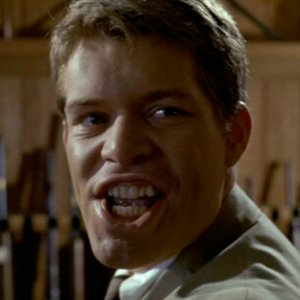 Two years later, Targets was released, written and directed by Peter Bogdanovich, but guided by the ghosts of Whitman and those he murdered. Actually, the sequence of Whitman’s day became the structure of the film. Plato could cite this as evidence of his theory of mimesis, which essentially means art imitates life. I’m inclined to believe it’s an example of how art recreates life – a desire to restore, or at least mourn, the disrupted order of the Creator whose image we bear.
Two years later, Targets was released, written and directed by Peter Bogdanovich, but guided by the ghosts of Whitman and those he murdered. Actually, the sequence of Whitman’s day became the structure of the film. Plato could cite this as evidence of his theory of mimesis, which essentially means art imitates life. I’m inclined to believe it’s an example of how art recreates life – a desire to restore, or at least mourn, the disrupted order of the Creator whose image we bear.
Rather like a young mechanic disassembles a toaster only to reassemble it, Bogdanovich seems passionately methodical in his commitment to remove all the parts of this incomprehensible happening and spread them out on the screen.
A Game of Scrabble
Oddly, research maintains that often the best method for solving a problem is to regularly distance and distract yourself from it. In Targets, the account of the young shooter, Bobby Thompson (Tim O’Kelly) is balanced by the retirement announcement of an old horror film star, Byron Orlok (Boris Karloff), who is preparing for one last appearance at a drive-in theatre. It’s a more unlikely duet than Tony Bennett and Lady Gaga, and even more uncannily effective.
As these two apparently unrelated stories cohabit the film, we are forced to accept that all life is irrevocably interrelated. Bogdanovich accomplishes this most stunningly through his transitions between their stories. “I think we should celebrate my freedom,” Orlok smiles at his assistant, as Bobby drives a Mustang with a trunk full of guns on the freeway. Bobby’s family prays before dinner as someone toasts Orlok in restaurant. A light goes off in one scene as a cigarette lights in the darkness of another.
The film develops like a game of Scrabble, with each scene a tile being set on the table, very slowly, without commentary, all of us awaiting the final word.
An Appointment in Samara
That word is hard, and gradually revealed throughout Targets. In one of Karloff’s most enrapturing and chilling scenes, he tells a story in rehearsal for his final appearance:
“Once upon a time, many years ago…a rich merchant in Baghdad sent his servant to the marketplace to buy provisions, and after awhile the servant came back white-faced and trembling and said, ‘Master, when I was in the marketplace I was jostled by a woman in the crowd and I turned to look and I saw that it was Death that had jostled me. And she looked at me and made a threatening gesture. Oh, Master, please, lend me your horse that I may ride away from this city and escape my fate. I will ride to Samara and Death will not find me there.’ So the merchant loaned him the horse and the servant mounted it and dug his spurs into its flank and as fast as the horse could gallop, he rode towards Samara. Then the Merchant went to the marketplace and he saw Death standing in the crowd and he said to her, ‘Why did you make a threatening gesture to my Servant when you saw him this morning?’ And Death said, ‘I made no threatening gesture; that was only a start of surprise. I was astonished to see him here in Baghdad, for I have an appointment with him tonight, in Samara.’”
It is tempting to patronize this soliloquy as a sort of Twilight Zone campfire story and a verbal set piece for the master of mood, Karloff, but it bears uneasy resemblance to a parable. The flesh counts for nothing, and Death will not be outrun. “The world belongs to the young,” Orlok pronounces like Solomon. “Let them have it.”
True wisdom is frequently ironic, and Orlok’s statement is a rebuff to the courting of a young writer, Sammy Michaels (Bogdanovich), who has written an opus for Orlok. Michaels is so unmistakably a mouthpiece for Bogdanovich that he just decided to play the character. He opines line after line, including “all the good movies have been made,” as he and Orlok watch The Criminal Code starring a young Karloff. No matter who or how old or young you are, there is always someone you would rather be, someone with more purity and promise.
No One Righteous
And we are all so certain we will never be Bobby Thompson, or Charles Whitman – Satan himself, masquerading as an Angel of Light – an Aryan beauty, an all American boy, the model in a toothpaste ad, clean and beautiful, climbing to heights and killing those below.
But we are not judges and there is no one righteous, not those who play monsters onscreen, nor those influenced to act like them in life. Orlok and Bobby’s lifelines are entwined ever tighter, until they are bizarrely and inexorably drawn to the same drive-in theatre – Orlok, for his last appearance, and Bobby, to elude the police.
Though I will refrain from disclosing one of the most iconic and ingeniously edited climaxes in film history, I will mention that the final shot is from above, of a lone car. I could not help but think of the lost sheep, identical to the rest of the flock, but the one that God pursues, even as Death schedules an appointment.
__________________________________________
*Thanks to Discovery News for the vital article on mass shootings and interview with Grant Duwe.
** According to an article published in the Washington Post, we are less violent now than we were in the late ‘60s. But of the twelve deadliest shootings in the United States, six have occurred from 2007 onward. Yet gun ownership has declined over the last few decades. None of this was relevant on April 16 of 2007 at the Virginia Tech campus in Blacksburg, or December 14 of 2012 at Sandy Hook Elementary School in Newton, Connecticut.
***Such are the facts that become Targets’ fiction, but its reasons for existence are not only tragic, but comic, too. At the time, Peter Bogdanovich was morphing from film critic to filmmaker, under the auspices of Roger Corman, as they worked on the latter director’s film, The Wild Angels. Corman, realizing that he was owed two days of work from actor Boris Karloff and had a talented youngster with classic taste in Bogdanovich, improvised a deranged movie deal, tied up with loose ends and tight planning. Corman offered $125,000 to Bogdanovich for his own project, provided he used Karloff for only two days of shooting, incorporated 20 minutes of footage from another Corman-Karloff film, The Terror, and recorded another 40 minutes of material without Karloff.**** Surely someone must have cautioned Bogdanovich that couldn’t make a quality film under such extreme conditions. But cinema, and indeed all art, is like a cactus or a polar bear – it thrives in extreme conditions.
****Thanks to The Dissolve for the fascinating history, informed interview of Bogdanovich and insightful review of Targets.

